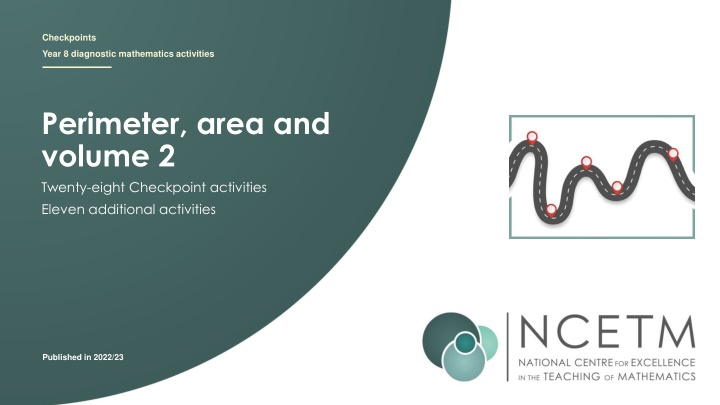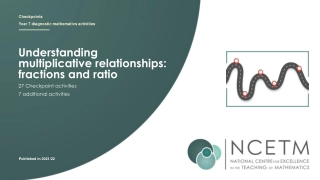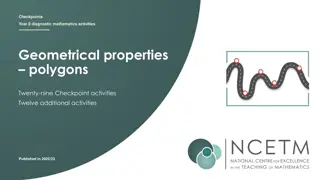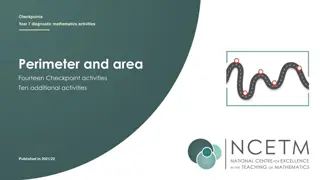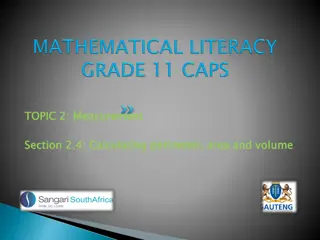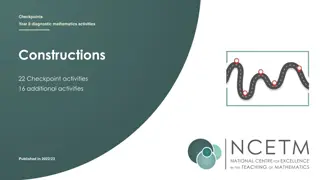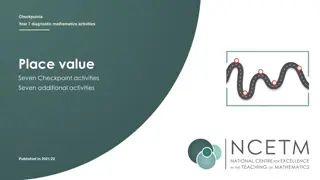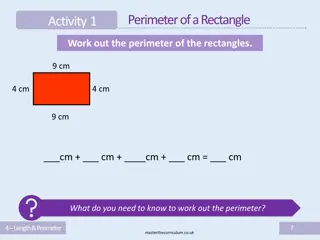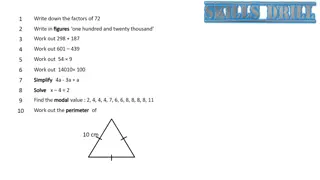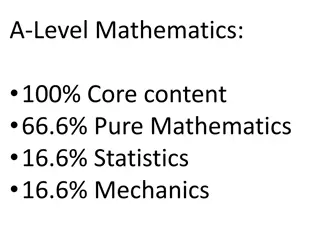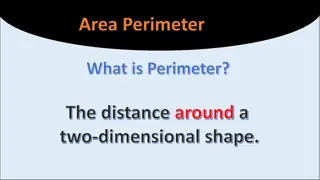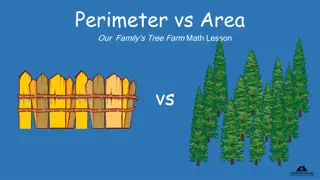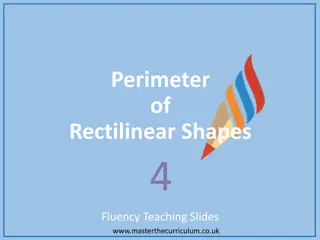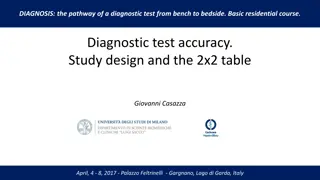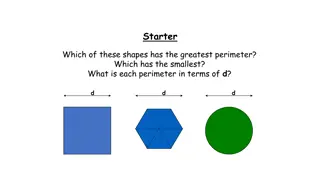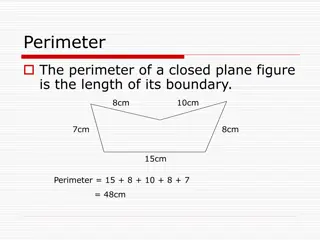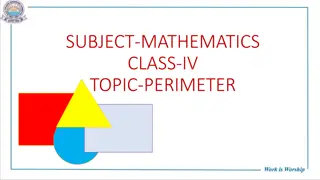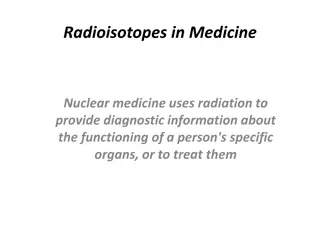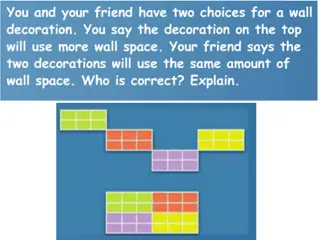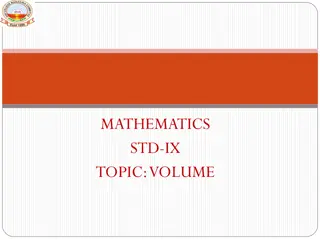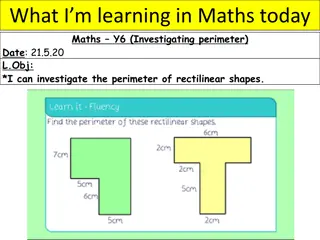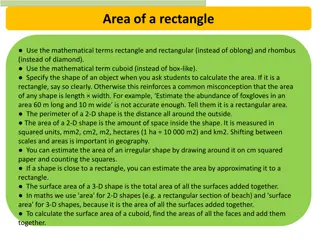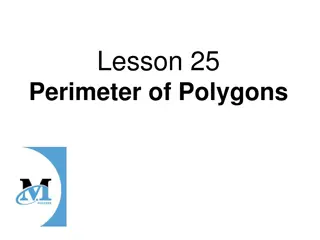Year 8 Diagnostic Mathematics Checkpoints: Perimeter, Area, and Volume Activities
Dive into a comprehensive collection of 28 Checkpoint activities, alongside 11 additional exercises, designed for Year 8 students to strengthen their understanding of perimeter, area, and volume. This newly published resource is packed with engaging tasks such as working with bricks, analyzing line drawings, and exploring Swedishish concepts. Perfect for reinforcing fundamental mathematics skills in an interactive and practical way.
Download Presentation

Please find below an Image/Link to download the presentation.
The content on the website is provided AS IS for your information and personal use only. It may not be sold, licensed, or shared on other websites without obtaining consent from the author.If you encounter any issues during the download, it is possible that the publisher has removed the file from their server.
You are allowed to download the files provided on this website for personal or commercial use, subject to the condition that they are used lawfully. All files are the property of their respective owners.
The content on the website is provided AS IS for your information and personal use only. It may not be sold, licensed, or shared on other websites without obtaining consent from the author.
E N D
Presentation Transcript
Checkpoints Year 8 diagnostic mathematics activities Perimeter, area and volume 2 Twenty-eight Checkpoint activities Eleven additional activities Published in 2022/23
Checkpoints 18 Checkpoint Underpins Code 1: Bricks 2: Swedishish 3: Line drawings Area and perimeter 6.2.1, 6.2.2 4: Trapezia 5: Most agreeable 6: Ants on a clock 6.2.1, 6.2.2 7: Semi-circular path Circles 8: Not full circle *This three-digit code refers to the statement of knowledge, skills and understanding in the NCETM s Sample Key Stage 3 Curriculum Framework (see notes below for more information).
Checkpoints 917 Checkpoint Underpins Code 9: Inside out? 10: Hole in the wall 11: Bird s-eye view 12: 3D three ways 13: Wrong uns 3D Shapes 6.2.3 14: Six faced 15: Four, five, six prisms 16: Prism break 17: Cubist 18: Dienes *This three-digit code refers to the statement of knowledge, skills and understanding in the NCETM s Sample Key Stage 3 Curriculum Framework (see notes below for more information).
Checkpoints 1928 Checkpoint Underpins Code 19: Twenty-eight cubes 20: Lunchboxes Concept of volume 6.2.3 21: Cold as ice 22: Blocks 23: Swimming pool 24: Cubes in a glass 25: Marshall s parcel Calculating volume 6.2.3 26: Same volume 27: Remembering rules 28: Twice as wide, twice as tall *This three-digit code refers to the statement of knowledge, skills and understanding in the NCETM s Sample Key Stage 3 Curriculum Framework (see notes below for more information).
Area and perimeter Checkpoints 1 5
Checkpoint 1: Bricks a) How many bricks have been removed to allow the square of concrete and drain cover to be put in? b) How did you work this out? Is there more than one way to show this? If the shortest side length of one brick is 15 cm, estimate the perimeter and area of the smaller metal drain cover square.
Checkpoint 2: Swedishish Some yellow shapes are drawn inside a blue square. For each yellow shape, decide whether its perimeter is greater or less than the perimeter of the blue square. a) b) c) d) e) f) Is it possible to arrange the shapes in order of perimeter, shortest to longest?
Checkpoint 3: Line drawings Four students use the line on the right as one side of a 2D shape. Each student tries to draw a different shape with the same area. Levi draws a rectangle. Which of the statements below are true and which are false? I need to make my triangle twice as tall as Levi s rectangle. My parallelogram needs to have the same length sides as Levi s rectangle. My trapezium needs to be the same height as Cassie's triangle Cassie Nico Salma Draw a rectangle, a triangle, a parallelogram and a trapezium that all have the same base length and area.
Checkpoint 4: Trapezia George wants to find the area of some trapezia using the formula area = ? He measures three sides and labels them a, b and h. Has he done this correctly for each trapezium below? a b ?(a + b)h. 34 cm 37 cm a h h A C 14 cm b h 21 cm a b 9 cm 28 cm 16 cm h 38 cm E a D b B 22 cm 19 cm a h 61 cm b 9 cm Estimate the area of each trapezium. Is it possible to calculate any of them accurately?
Checkpoint 5: Most agreeable To find the area of a trapezium, you need . Three students say how they would complete this sentence. a horizontal length. the lengths of three sides. the lengths of the parallel sides. Flavian Shahzeb Joris a) Whose answer is most correct? Why? b) Think of a better statement than the three given. Sketch an example of a trapezium where each person s rule could be used. Is it possible to sketch an example where their rule could not be used?
Checkpoint 5: Most agreeable (solutions to the further thinking question) To find the area of a trapezium, you need the lengths of the parallel sides. a horizontal length. the length of three sides. Examples Non-examples Not possible you always need the lengths of the parallel sides.
Circles Checkpoints 6 8
Checkpoint 6: Ants on a clock A Two ants are sitting on a clock. Ant A walks in a straight line to 6. Ant B walks in a straight line to 4. a) What can you say about the distances each ant walks? b) If they reach their new numbers in the same time, what can you say about the speed of the ants? B Both ants walk back to where they started and then ant B also walks to join ant A at 12. c) Which ant walks the furthest this time? d) Which ant has walked the furthest in total? Ant A walks around the circumference of the clock. Ant B walks from 12 to 6 and back again. If they walk at the same speed, which ant will get back to 12 first?
Checkpoint 7: Semi-circular path A garden has a semi-circular path. Alex walks from A to B to C. Brian walks from B to D to A. Colin walks from C to D to A. Dave walks from D to B to A. Put their four journeys in order from shortest to longest. How did you decide? Estimate how many times further Colin's journey was compared to Alex s journey.
Checkpoint 8: Not full circle Beau has a semi-circle. Halle has a quarter-circle. Both of their shapes are cut from the same circle. Halle says, The area of my quarter-circle is half the area of your semi-circle. a) Is Halle correct? Why or why not? Beau Halle Beau says, The perimeter of my semi-circle is twice the perimeter of your quarter-circle. b) Is Beau correct? Why or why not? Beau Halle cuts her quarter-circle into five equal pieces. What can you say about the area and perimeter of one of these sectors compared to Beau s semi-circle?
3D shapes Checkpoints 9 18
Checkpoint 9: Inside out? a) Are these two pictures of the same shape? How do you know? b) How many vertices are there on each shape? c) How many blue rods make up each shape? d) Richard cuts out shapes to cover the gaps. How many will he need? Will they all be the same shape and size? Design another 3D shape with triangular faces. How many vertices, edges and faces does it have?
Checkpoint 10: Hole in the wall Will the block fit through the hole in the wall in each of these situations? e) c) a) d) b) Design a different shape that would fit through each hole.
Checkpoint 11: Birds-eye view a) Viewed from directly above, in 2D, which of the four buildings could the sketch on the right represent? b) How did you decide? c) How about the sketch below? Eiffel Tower, Paris Elizabeth Tower, London Choose one of the other buildings and sketch what it might look like from above. Great Pyramid, Egypt One Canada Square, London
Checkpoint 11: Birds eye view (solution to further thinking question) Choose one of the other buildings and sketch what it might look like from above. Elizabeth Tower, London One Canada Square, London
Checkpoint 12: 3D three ways Three students represent the same cuboid but in three different ways. Neesha Beth Finlay a) What is the same and what is different about each drawing? b) When might each drawing be a useful way to represent a 3D shape? Imagine a square-based pyramid. What would each student s representation of this shape look like?
Checkpoint 12: 3D three ways (possible solutions to further thinking question) Imagine a square-based pyramid. What would each student s representation of this shape look like? Finlay Neesha Beth
Checkpoint 13: Wrong uns What is wrong with these nets? How could you correct them? Cuboid a) c) b) Triangular prism Cube e) Cylinder f) Cylinder d) Triangular prism Draw a different correct net for each 3D shape.
Checkpoint 14: Six faced A teacher asks her class to draw the net of a cube. Study the first five faces that five students draw in turn. Where could they put their sixth face? Is there more than one answer? Arun Logan Phoebe Niamh Fred Is there a different net that doesn t use these starting points?
Checkpoint 14: Six faced (animated solutions) Phoebe Fred Logan Arun Niamh There is one more net which doesn t use these starting points.
Checkpoint 15: Four, five, six prisms Phil has four cubes. a) Using all his cubes, how many different prisms can he make? Rose-Marie has five cubes. b) Using all her cubes, how many different prisms can she make? Sachin has six cubes. c) Has he made a prism? If not, which cube(s) should he move? How many prisms could Sachin make with his six cubes?
Checkpoint 15: Four, five, six prisms (solutions to parts a and b)
Checkpoint 15: Four, five, six prisms (solutions to further thinking question) There are thirty-seven possible prisms. One is two rows of three cubes, as shown below. Thirty-six are different arrangements of six cubes, creating a prism with cross-sectional area of six and length of one. Seven of the thirty-six examples are shown below.
Checkpoint 16: Prism break A prism is broken into three identical pieces. 4 cm 1 cm 10 cm a) Sketch the original prism. What are the dimensions of your sketch? b) Is there more than one possible answer to part a? Sketch and label your own congruent pieces for a different prism. How many different prisms could they be for?
Checkpoint 16: Prism break (animated solutions) 10 cm 4 cm 1 cm 30 cm 12 cm 10 cm 4 cm 8 cm 3 cm 4 cm 1 cm 10 cm 1 cm 20 cm 1 cm 20 cm 2 cm 8 cm 4 cm 1 cm 4 cm 10 cm 2cm 10 cm
Checkpoint 17: Cubist Pablo has exactly enough paint to cover all the faces of eight small cubes. Before he paints them, he makes a bigger cube from the small cubes. a) Does he have enough paint to cover the six faces of the big cube? b) Will he have enough paint left over to cover another big cube of the same size? Pablo makes an even bigger cube from small cubes. What is the least number of cubes he can use? How would your answers to parts a c change?
Checkpoint 18: Dienes Jimmi has some Dienes blocks. The length of the smallest cube is 1 cm. a) What is the volume of each different block? b) What lengths have you used to calculate each volume? Jimmi notices that each block has six faces. He writes the area of each face in a table. c) Complete Jimmi s table. What do you notice? Face1 1 cm2 1 cm2 10 cm2 Face3 Face4 Face5 Face 2 Face 6 Ones Tens Hundreds Thousands 10 cm2 Imagine a ten thousands block. Sketch what it might look like. What could be the area of each face then? How about a hundred thousands block?
Checkpoint 18: Dienes (solution to further thinking question) Imagine a ten thousands block exists. Sketch what it might look like. What could be the area of each face then? How about a hundred thousands block?
Concept of volume Checkpoints 19 22
Checkpoint 19: Twenty-eight cubes Guz makes a shape out of 28 multilink cubes. Callum breaks it apart and makes a different shape using all 28 cubes. a) Do you agree that the volume of the shapes is the same? Gabriel breaks it apart and makes a different shape using all 28 cubes. b) Do you agree that the volume of the shapes is the same? Is it possible to make this shape using exactly 28 cubes? Explain your thinking.
Checkpoint 20: Lunchboxes a) Which of these containers has the greatest capacity? b) How do you know? How might you check? Fran counts the sandwiches in the containers. She says, I can only fit two sandwiches into the cylindrical box but three into the cuboid box. So the cylinder must have a smaller capacity than the cuboid. c) Is Fran correct? Why or why not? Both containers have the same volume. A third container also has the same volume. It is exactly wide and high enough to fit one sandwich. Sketch what this container could look like.
Checkpoint 21: Cold as ice Becky fills this cup of water. Becky then pours the water into an ice cube tray, without spilling any, and puts the tray in the freezer. Finally, Becky tips the frozen ice cubes from the tray back into the cup. a) Will the ice cubes fit? Why or why not? b) How about if the ice cubes were smaller? c) How about if the cup was a cylinder? Or a cuboid? Each space in the tray is cubic and has a length of 3 cm. When the water is poured into the tray, it fills two-thirds of the spaces. Does the cup have a volume greater than 100 cm3?
Checkpoint 22: Blocks This cube is made from 27 blocks Each of the corner blocks (coloured white) is removed. a) Does the volume of the shape increase, decrease or stay the same? b) How about the number of faces? c) How about the total area of the faces? Is it possible to make a shape with a greater volume but the same surface area? How about the same volume but a greater surface area? Justify your answers.
Calculating volume Checkpoints 23 28
Checkpoint 23: Swimming pool Russell is renovating an old outdoor swimming pool. It has a rectangular surface and is the same depth at all points. What does he need to measure to ensure he has the items listed in parts a to c? a) Enough fencing to go around the perimeter of the pool. b) A big enough cover to go over the top of the pool. c) Enough water to fill the pool. Russell measures one dimension to be 25 m. Which dimension of the pool is this likely to be? What would be a reasonable estimate for the perimeter, area and volume?
Checkpoint 24: Cubes in a glass Shona fills a glass with cubes of length 2 cm. Courtney fills an identical glass with cubes of length 1 cm. a) Estimate how many of each type of cube are in the glasses. There are 14 in Shona s glass and 160 in Courtney s. b) Why are these numbers so different? Shona and Courtney use their cubes to estimate the volume of their glasses. c) Whose estimate is most likely to be accurate? Why? Shona estimates her glass has a volume of 28 cm3. Courtney estimates her glass has a volume of 160 cm3. Do you agree with these estimates? Why? How could they be improved?
Checkpoint 25: Marshalls parcel Marshall is sending a parcel and needs a box with a minimum volume of 420 cm3. a) Which of these boxes could he use? E D A 8 cm 5 cm 2 cm C 8 cm 42 cm 10 cm B 8 cm 6 cm 10 cm 10 cm 8 cm 2 cm 22 cm 20 cm 2 cm b) The item in Marshall s parcel is a book 21 cm long. Does this information change your answer to part a? Sketch some other boxes that Marshall could use.
Checkpoint 26: Same volume a) What is the volume of cuboid A? 4 cm A 4 cm 5 cm 6 cm b) Cuboids B to E all have the same volume as cuboid A. What are the missing lengths? 2 cm ? cm 10 cm ? cm 8 cm E B 5 cm D C 3 cm 10 cm ? cm ? cm 6 cm ? cm 12 cm Sketch some other boxes with the same volume. Can you sketch a cube? Why or why not?
Checkpoint 27: Remembering rules Billy says, To find the volume of a shape you just need to multiply the lengths together. a) Which of these shapes does Billy s rule work for? A B C D 5 m 1 m 5 m 3 m 4 m 3 m 1 m 2 m 5 m 60 cm 2 m 4 m 3 m 4 m 4 m 3 m 1 m 5 m 20 cm b) Can you improve Billy s rule? Find the volume of each of the shapes. Are they all possible? Can you estimate the volume of any that are not?
Checkpoint 28: Twice as wide, twice as tall On the right are three cylinders. Cylinder B is twice as wide as cylinder A. Cylinder C is twice as tall as cylinder A. a) Does B or C have the greater volume, or do they have the same volume? A C B On the right now are three cuboids. Cuboid E is twice as wide as cuboid D. Cuboid F is twice as tall as cuboid D. b) Does E or F have the greater volume, or do they have the same volume? D E F How would your answers change if the shapes were triangular prisms?
Checkpoint 28: Twice as wide, twice as tall (solutions) A A A A B C A D E D F D D D
Additional activities Activities A K
Activity A: Tiles The picture shows a tiled doorstep. The yellow square is 20 tiles across and 20 tiles high. Jake says 20 20 = 400, so there are 400 tiles in the square. Vanessa says that 400 is a good estimate, but not an accurate answer. Who is correct? Explain why. Do you think that Jake s answer is likely to over- or under-estimate? Explain why.
Activity B: Cups A tray of cups is placed in the staffroom for breaktime. a) How many more cups are needed to fill the tray? How do you know? Each cup has a radius of 5 cm. b) Use this to estimate the perimeter and area of the tray the cups are on. Trays of cups are stacked on top of each other for a school event. How many trays are needed if there are 211 attendees? How many attendees might there be if four trays are provided?
Activity C: Nets Priya uses some smaller shapes to make bigger shapes, A to E. Each length in the smaller shapes is 1 cm. A B C D E a) Put shapes A to E in ascending order of perimeter. What do you notice? b) Put the shapes in ascending order of area. What do you notice? Priya uses her shapes as nets. She cuts out around the perimeters and folds along the internal lines c) Which 3D shapes has she made nets for? Can you make any other nets for the same shapes? Where would they go in your orders for part a and b?
